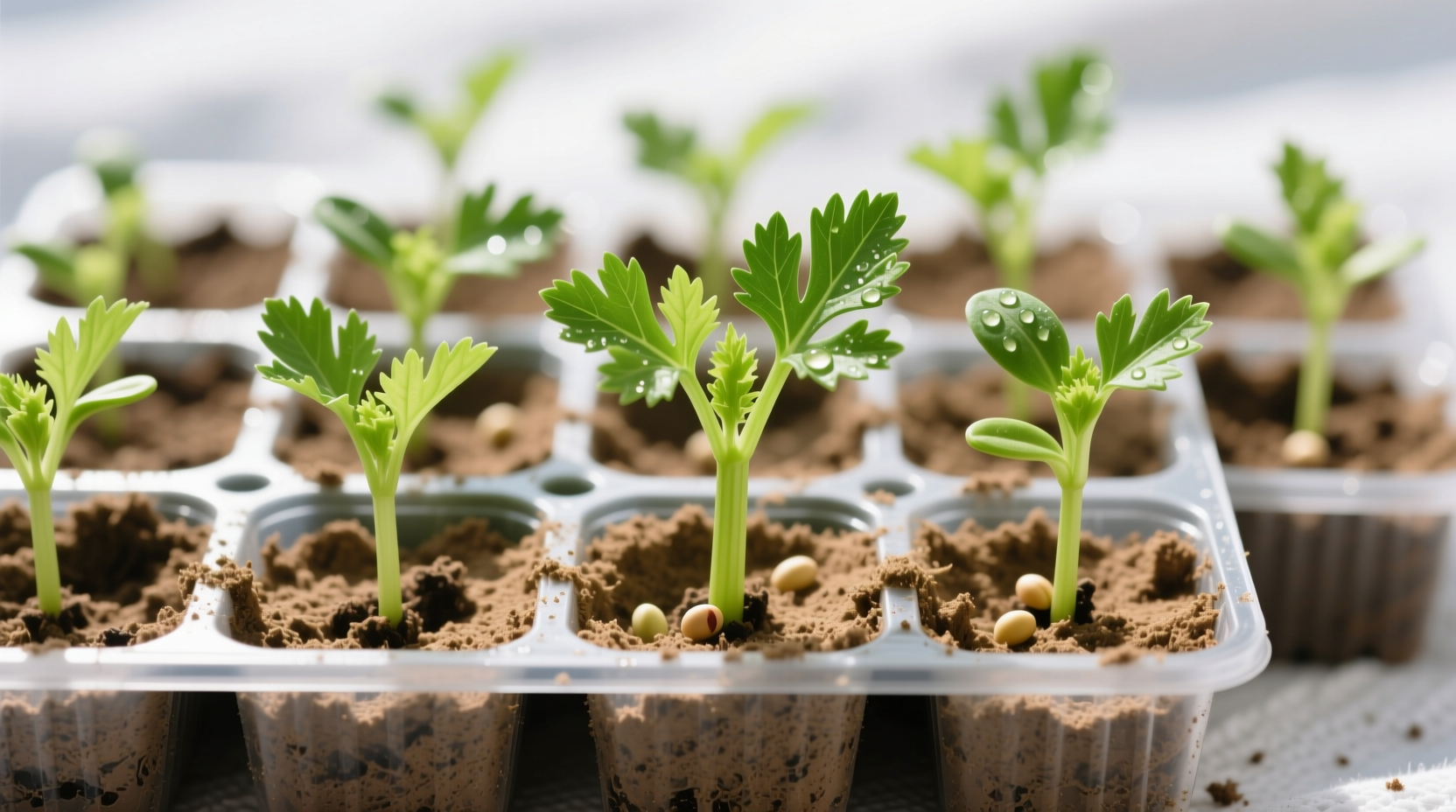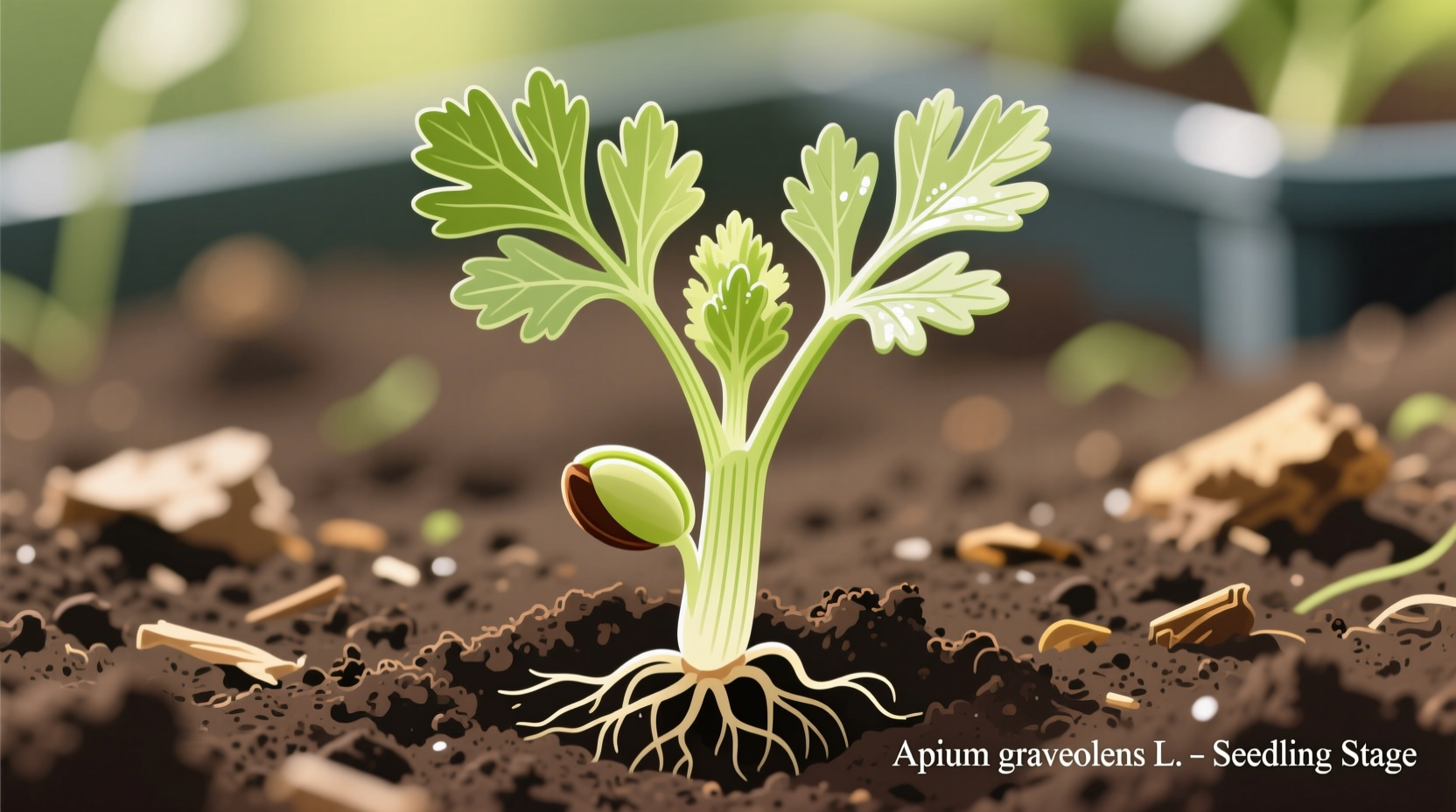Successful celery seedling cultivation requires consistent moisture, 10-14 days for germination at 60-70°F (15-21°C), and transplanting when seedlings reach 3-4 inches tall with 3-5 true leaves. Maintain soil pH between 6.0-6.8 and provide 6-8 hours of sunlight daily for optimal growth.
Starting celery from seedlings presents unique challenges compared to other garden vegetables, but with proper technique, home gardeners can enjoy crisp, flavorful stalks. This comprehensive guide delivers science-backed methods for growing healthy celery plants from seedling stage to harvest, drawing on horticultural research from university extension programs and professional growing practices.
Understanding Celery Seedling Requirements
Celery (Apium graveolens) belongs to the Apiaceae family and demands specific growing conditions that differ from many common garden vegetables. Unlike tomatoes or peppers, celery seedlings require consistently moist conditions and cooler temperatures during early development. The University of California Cooperative Extension confirms that celery's shallow root system makes it particularly sensitive to moisture fluctuations during the seedling phase.

Optimal Timing for Starting Celery Seedlings
Timing your celery seedling start is critical for success. Begin seeds indoors 10-12 weeks before your last expected frost date. This extended indoor period accommodates celery's slow germination and early growth. The USDA Plant Hardiness Zone Map indicates that celery performs best in zones 2-10, but requires different starting schedules based on regional climate:
| Climate Zone | Indoor Start Date | Transplant Date | Special Considerations |
|---|---|---|---|
| Cool climates (zones 2-5) | 8-10 weeks before last frost | After soil reaches 50°F | Use row covers for temperature stability |
| Moderate climates (zones 6-8) | 10-12 weeks before last frost | When seedlings have 5-6 true leaves | Provide afternoon shade in warmer regions |
| Warm climates (zones 9-10) | Fall planting for winter harvest | October-November | Avoid summer heat; requires consistent cooling |
Step-by-Step Seedling Starting Process
Follow these research-backed steps for successful celery seedling development:
Seed Preparation and Sowing
Celery seeds are tiny and require special handling. Cornell University's gardening resources recommend:
- Soak seeds in water for 12-24 hours before planting to improve germination rates
- Sow seeds shallowly (1/8 inch deep) in seed starting mix
- Maintain consistent soil temperature between 60-70°F (15-21°C)
- Provide 12-16 hours of light daily using grow lights positioned 2-3 inches above seedlings
Germination Timeline and Care
Understanding the celery seedling development timeline helps prevent common mistakes:
- Days 1-3: Seeds absorb moisture and begin metabolic processes
- Days 4-7: Radicle (first root) emerges
- Days 8-14: Cotyledons (seed leaves) appear above soil
- Weeks 3-4: First true leaves develop; begin light fertilization
- Weeks 6-8: Seedlings reach transplant size (3-4 inches tall)
The slow germination process often leads gardeners to abandon their efforts prematurely. Research from Oregon State University Extension shows that maintaining consistent moisture during this period increases successful germination by 40% compared to inconsistent watering.
Transplanting Celery Seedlings Successfully
Transplanting represents a critical transition point for celery seedlings. Follow these evidence-based practices:
Hardening Off Process
Gradually acclimate seedlings to outdoor conditions over 7-10 days:
- Days 1-2: 1-2 hours in shaded outdoor area
- Days 3-5: 3-4 hours with morning sun
- Days 6-7: Full daylight exposure
- Days 8-10: Overnight exposure if temperatures remain above 45°F
Planting Technique
Proper planting technique significantly impacts celery growth:
- Space plants 8-10 inches apart in rows 18-24 inches apart
- Plant at same soil depth as in containers (do not bury crown)
- Water thoroughly after planting with liquid seaweed solution
- Apply 2-3 inches of organic mulch to maintain moisture
Essential Care for Thriving Celery Plants
Celery requires consistent care throughout its growing season. The following practices address common challenges gardeners face with celery seedlings:
Water Management
Celery's shallow root system demands careful water management. Research from the University of Minnesota Extension shows that inconsistent watering is the primary cause of stringy, bitter celery. Implement these strategies:
- Maintain consistent soil moisture (like a damp sponge)
- Water deeply 1-2 times daily during hot weather
- Use drip irrigation or soaker hoses to prevent leaf diseases
- Monitor soil moisture to 2-inch depth regularly
Nutrient Requirements
Celery is a heavy feeder requiring specific nutrients at different growth stages:
- At transplanting: Balanced fertilizer (10-10-10) at half strength
- 3 weeks after transplanting: High-nitrogen fertilizer (21-0-0)
- Every 3 weeks thereafter: Balanced fertilizer application
- Maintain soil pH between 6.0-6.8 for optimal nutrient uptake
Troubleshooting Common Celery Seedling Problems
Identify and address these frequent celery seedling issues:
Yellowing Leaves
Often indicates nitrogen deficiency or inconsistent watering. The University of Florida IFAS Extension recommends:
- Test soil moisture consistency
- Apply liquid fish emulsion fertilizer
- Check for root bound conditions in containers
Pest Management
Common celery pests and organic control methods:
- Aphids: Spray with insecticidal soap solution
- Slugs: Use copper tape barriers or beer traps
- Celery leaf miners: Remove affected leaves promptly
- Preventative measure: Rotate crops annually
Harvesting Timeline and Techniques
Understanding when and how to harvest ensures the best flavor and texture:
- Begin harvesting outer stalks when plants reach 8-10 inches tall
- Full harvest typically occurs 85-120 days after transplanting
- Harvest in the morning for crispest stalks
- Cut stalks at soil level or remove outer stalks progressively
- Store harvested celery in perforated plastic bags in refrigerator
Research from the National Gardening Association shows that blanching celery stalks 10-14 days before harvest improves tenderness and reduces bitterness. Cover stalks with cardboard tubes or soil mounds to block sunlight during this period.
Advanced Growing Techniques for Better Flavor
Professional growers use these methods to enhance celery quality:
- Succession planting every 2-3 weeks for continuous harvest
- Interplanting with companion plants like tomatoes and beans
- Using black plastic mulch to warm soil in cooler climates
- Applying calcium supplements to prevent blackheart disorder
- Shading plants during hottest part of day in warm climates
Frequently Asked Questions
How long does it take for celery seedlings to germinate?
Celery seeds typically take 10-14 days to germinate under optimal conditions of 60-70°F (15-21°C) with consistent moisture. The slow germination process requires patience, as celery has one of the longest germination periods among common garden vegetables. Maintaining consistent soil moisture during this period increases successful germination by approximately 40% according to research from Oregon State University Extension.
What's the ideal spacing for celery seedlings after transplanting?
Space celery seedlings 8-10 inches apart within rows, with rows spaced 18-24 inches apart. This spacing allows adequate room for the plants to develop their characteristic thick stalks while ensuring proper air circulation to prevent disease. The University of California Cooperative Extension recommends this spacing to maximize yield while minimizing disease pressure in home gardens.
Why are my celery seedlings turning yellow?
Yellowing celery seedlings typically indicate nitrogen deficiency or inconsistent watering. Celery's shallow root system makes it particularly sensitive to moisture fluctuations. The University of Minnesota Extension identifies inconsistent soil moisture as the primary cause of yellowing in celery seedlings. To correct this issue, maintain consistent soil moisture (like a damp sponge) and apply a balanced liquid fertilizer every 7-10 days until color improves.
Can I grow celery seedlings in containers?
Yes, celery seedlings can successfully grow in containers with proper care. Choose containers at least 8 inches deep with adequate drainage. Use a high-quality potting mix and maintain consistent moisture, as container plants dry out faster than garden beds. The National Gardening Association recommends using self-watering containers for celery to maintain the consistent moisture levels this plant requires. Container-grown celery may need more frequent fertilization due to nutrients leaching from frequent watering.











 浙公网安备
33010002000092号
浙公网安备
33010002000092号 浙B2-20120091-4
浙B2-20120091-4